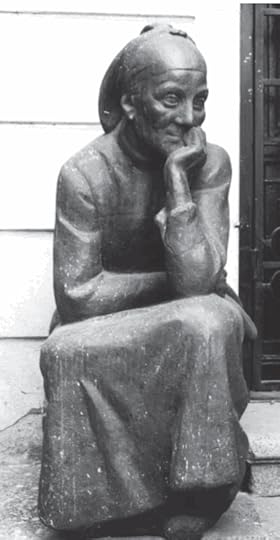Marc Abrahams's Blog, page 565
June 30, 2012
Putrefaction of Diogenes Postponed
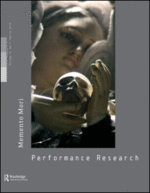 If you read only one scholarly article about the putrefaction of Diogenes postponed, perhaps that article should be:
If you read only one scholarly article about the putrefaction of Diogenes postponed, perhaps that article should be:
“The Putrefaction of Diogenes Postponed: Memento mori in the work of Robert O. Lenkiewicz (1941-2002),” M.A . Penwill, Performance Research, vol. 15, no. 1 March 2010 , pp. 110-22. DOI: 10.1080/13528165.2010.485771.

June 29, 2012
That green stuff on Bulgarian statues
A look back at that exciting moment when humans took the first hard, analytic look at the green muck that grows on Bulgarian statues [one of which is pictured below]. It’s all described, in and between the lines, in the monograph:
“First Study of Aerophytic Cryptogams on Monuments in Bulgaria,” Georg Gartner and Maya P. Stoyneva,Ber. nat.-med. Verein Innsbruck Band, 90 S. 73-82 Innsbruck, Nov. 2003.
“The first study of aerophytic cryptogams from granite monuments investigated in the Bulgarian town Koprivshtitsa (Sredna Gora Mountains – 1058 m a.s.l.) compared with two identical bronze and limestone copies in the capital town Sofia (650 m a.s.l.) is presented…. The algal taxa have been studied in cultures and some comments on their taxonomy and distribution are given.”

June 28, 2012
Larissa Unruh joins Hair Club (LFHCfS)
Larissa Unruh has joined the Luxuriant Flowing Hair Club for Scientists (LFHCfS). She says:
It is ridiculously hard being the wearer of such incredibly luxuriant flowing hair. Not only do I have to deal with the envious stares of those with lesser hair, but I have to spend a lot of time trouble shooting to ensure that my hair remains both optimally luxuriant and flowy. I am ecstatic to have found a group specifically for scientists, such as myself, who have been endowed with such fabulous locks. I am currently working as a crystallography research assistant at the University of Oregon studying mutations in a red fluorescent protein called mKeima. However, I will be shifting my focus, if not my hairstyle, in July 2012 when I start as a research epidemiologist for the San Joaquin County Department of Pubic Health Services.
Larissa Unruh, BS, MPH, LFHCfS
Biophysics/Crystallography Research Assistant
Remington Lab
University of Oregon, Eugene, Oregon, USA
In July 2012, I will become an epidemiologist for the San Joaquin County Department of Public Health Services, Stockton, California, USA.


The Virtual Pigeon’s Progress
 Professor Shigeru Watanabe was one of the co-winners of the 1995 IgNobel psychology prize (for success in training pigeons to discriminate between the paintings of Picasso and those of Monet.) Since then, the professor’s research team at Keio University, Japan, have linked up with Queen’s University, Ontario, Canada, to create and test what could well be the world’s first 3-D virtual pigeon – for use in avian social perception investigations. The same 3-D modelling and rendering software used to create special effects for Batman Forever (Alias Wavefront®) was used to construct the cyber avian. Next, a series of laboratory tests with four experimentally naïve pigeons (obtained from the Japanese Association of Racing Pigeons) confirmed that they were, on the whole, reasonably convinced by the Computer Graphic (CG) bird.
Professor Shigeru Watanabe was one of the co-winners of the 1995 IgNobel psychology prize (for success in training pigeons to discriminate between the paintings of Picasso and those of Monet.) Since then, the professor’s research team at Keio University, Japan, have linked up with Queen’s University, Ontario, Canada, to create and test what could well be the world’s first 3-D virtual pigeon – for use in avian social perception investigations. The same 3-D modelling and rendering software used to create special effects for Batman Forever (Alias Wavefront®) was used to construct the cyber avian. Next, a series of laboratory tests with four experimentally naïve pigeons (obtained from the Japanese Association of Racing Pigeons) confirmed that they were, on the whole, reasonably convinced by the Computer Graphic (CG) bird.
“…the present results suggest that the virtual pigeon seems to be perceived as a real pigeon for the observing pigeons.”
Unfortunately, the resulting paper (published in Animal Cognition Volume 9, Number 4, pp.271-279) doesn’t have any photos of the CG bird – but Improbable has commissioned the creation of our own, different, 3-D ‘Virtual Pigeon’ which we present above (note: owing to the lack of photos in the paper, the degree of similarity with the team’s original is unknown.)
Towards a “virtual pigeon”: A new technique for investigating avian social perception can be read in full here.

June 27, 2012
How do pedestrians avoid collisions?
As you walk city streets, frustrated at why those other pedestrians behave so frustratingly, be aware that scientists are trying to improve the situation, but are making progress only in slow steps.
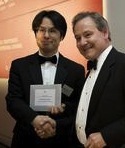 Dr Taku Fujiyama [pictured here, receiving an award], one of the modern masters in this endeavour, is a lecturer at University College London’s Secret Centre, or “the £17m international centre for PhD training in security and crime-relatedresearch“.
Dr Taku Fujiyama [pictured here, receiving an award], one of the modern masters in this endeavour, is a lecturer at University College London’s Secret Centre, or “the £17m international centre for PhD training in security and crime-relatedresearch“.
Fujiyama began his work before joining Secret. In 2005, while affiliated (as he still is) with UCL’s Centre for Transport Studies, he published a study called Investigating Use of Space of Pedestrians. It proposed a series of experiments in and on a mobile lighting-and-sound-system-equipped “elevated demountable paved platform”.
Different kinds of people – old, young, fat, thin – ambled and strode along the platform. A laser tracking system monitored their every motion and stoppage.
One early experiment focused on how people avoid collisions….
So begins this week’s Improbable Research column in The Guardian.

June 26, 2012
Hairy Ball Update 2012
The Hairy Ball Theorem (HBT) was first postulated (and then proved) by Luitzen Egbertus Jan Brouwer in 1912. An informal statement of the theorem is that :
“One cannot comb the hair on a coconut”.
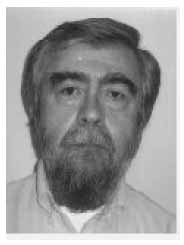
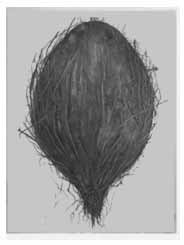 Temptations to classify the theorem as trivial should be strongly resisted – as it’s still finding relevance in many current research areas. Take, for example, the domain of Quantum Field Theory – the quote above coming from one of the latest research articles in which it features, a paper by Dr. Cihan Saçlioğlu (pictured) of the Faculty of Engineering and Natural Sciences, at Sabanci University, Istanbul, Turkey. ‘Conservation laws, equivalence principle and forbidden radiation modes.’ (Published in the journal Resonance, Volume 17, Number 3, 2012),
Temptations to classify the theorem as trivial should be strongly resisted – as it’s still finding relevance in many current research areas. Take, for example, the domain of Quantum Field Theory – the quote above coming from one of the latest research articles in which it features, a paper by Dr. Cihan Saçlioğlu (pictured) of the Faculty of Engineering and Natural Sciences, at Sabanci University, Istanbul, Turkey. ‘Conservation laws, equivalence principle and forbidden radiation modes.’ (Published in the journal Resonance, Volume 17, Number 3, 2012),
Dr. Saçlioğlu’s paper not only draws attention to the relevance of the HBT to the study of electromagnetic and gravitational radiation (monopolic and dipolic), but also points out that :
“On the other hand, one can comb the hair on a doughnut”
The paper can be read in full here :
BONUS An artist’s impression of an un-combed hairy doughnut can be found here:

June 25, 2012
How smoking can save your life [B. Russell]
Bertrand Russell, the eminent and no longer alive philosopher and mathematician, explains how pipe smoking saved his life.
(Thanks to Ever So Strange for bringing this to our attention.)

June 24, 2012
Railway vibrations – part 2 ‘Jiggling’
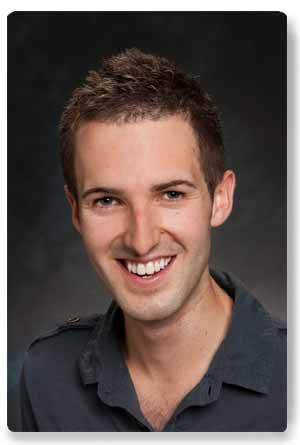 We’ve previously looked at the role of the rail track and wheels in inducing vibrations in trains – (see: Railway vibrations – part 1 – Graunching ) now it’s time to turn to the effect of vibrations on the rail passengers themselves. Dr. David Bissell – a lecturer at the Australian National University’s College of Arts and Social Sciences, is researching public transport, stillness, and the lack of it.
We’ve previously looked at the role of the rail track and wheels in inducing vibrations in trains – (see: Railway vibrations – part 1 – Graunching ) now it’s time to turn to the effect of vibrations on the rail passengers themselves. Dr. David Bissell – a lecturer at the Australian National University’s College of Arts and Social Sciences, is researching public transport, stillness, and the lack of it.
An example publication is : Vibrating materialities: mobility–body–technology relations (Area, Volume 42, Issue 4, pages 479–486, December 2010) in which the author documents the effects of vibration – and in particular ‘jiggling’ during rail journeys. As a result of his 1,500 hours of train journeys over a period of four years or so, he has built up a complex picture of ‘jiggling’ :
“… it is the memory of jiggling about that is perhaps most inescapable: the small, not exactly traumatic but certainly unrelenting shakes, quivers and vibrations that the body in transit has to endure in order to move.”
And, more generally, for rail travellers -
“Vibrations […] are an ever-present admonition that one’s body is being thrust though a landscape”.
In summary, how does this paper contribute to debates that consider the corporeal experience of mobilities?
“Drawing on some experiences of railway travel in Britain, it explores the experience of movement through the event of vibration. Vibration opens up ways of thinking about the uncertain and provisional connections between bodies, their travelling environments and the experience of movement that do not rely on dualistic or causal renderings of materiality. As such, this paper explores the generative possibilities that vibration opens up by considering how vibration [sic] change the shape of body–technology assemblages; challenge us to think about different assemblages in terms of their capacity for absorption, diffusion and transmission; and generate particular collectives. The paper concludes by considering how these vibrations sit within contemporary sensory economies of smoothness and turbulence.”
The paper can be read in full here.

June 23, 2012
Mathematics, Morally
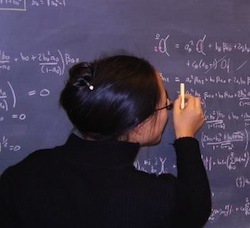 Eugenia Cheng [pictured here] thought long and hard about the, or at least a, relationship between mathematics and morality. She wrote up those thoughts and delivered them in a talk called “Mathematics, Morally“ on 23rd January, 2004, at the Cambridge University Society for the Philosophy of Mathematics. Cheng writes:
Eugenia Cheng [pictured here] thought long and hard about the, or at least a, relationship between mathematics and morality. She wrote up those thoughts and delivered them in a talk called “Mathematics, Morally“ on 23rd January, 2004, at the Cambridge University Society for the Philosophy of Mathematics. Cheng writes:
The first thing to be clear about is that I’m not talking about human morality. I’m not talking about whether it’s immoral to do mathematics, I’m not talking about ethical dilemmas that apply to mathematicians,”oh no, what if this equation gets into the wrong hands”. This is not morality for mathematicians but morality for mathematics.
Cheng is now a Senior Lecturer in the Department of Mathematics, University of Sheffield.
BONUS: Cheng muses about monads.
Cheng on monads: < http://www.youtube.com/TheCatsters>

June 22, 2012
Otherwise Impaired, Perceiving the Possibly Impossible
Today’s mind-twisty research study to ponder:
“Virtual lesion of ventral premotor cortex impairs visual perception of biomechanically possible but not impossible actions,” Matteo Candidi [pictured here], Cosimo Urgesi, Silvio Ionta and Salvatore M. Aglioti, Social Neuroscience, Volume 3, Issue 3-4, 2008. The authors are at the University of Rome and other institutions in Italy.

Marc Abrahams's Blog
- Marc Abrahams's profile
- 14 followers




